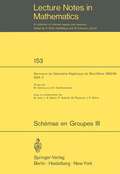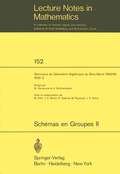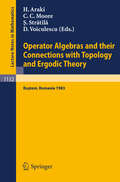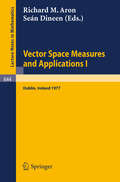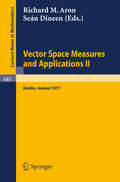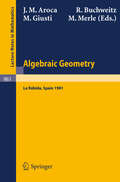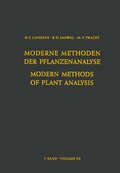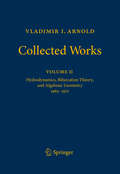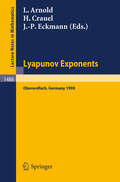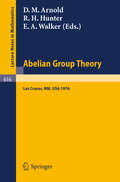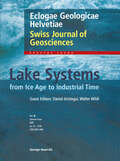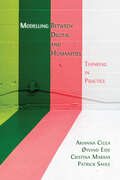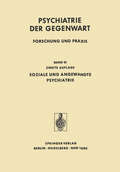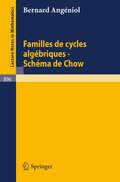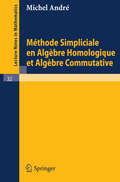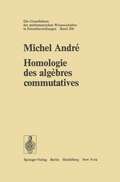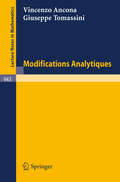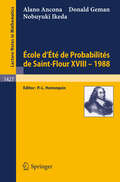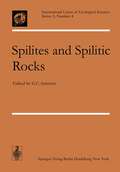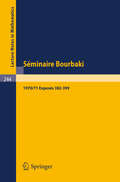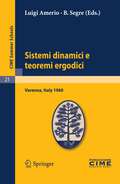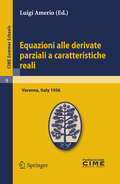- Table View
- List View
Schemas en Groupes. Seminaire de Geometrie Algebrique du Bois Marie 1962/64: III: Structure des Schemas en Groupes Reductifs (Lecture Notes in Mathematics #153)
by M. ArtinSchemas en Groupes. Seminaire de Geometrie Algebrique du Bois Marie 1962/64: II: Groupes de Type Multiplicatif, et Structure des Schemas en Groupes Generaux (Lecture Notes in Mathematics #152)
by M. ArtinOperator Algebras and their Connections with Topology and Ergodic Theory: Proceedings of the OATE Conference held in Busteni, Romania, August 29 - September 9, 1983 (Lecture Notes in Mathematics #1132)
by G. ArseneVector Space Measures and Applications I: Proceedings, Dublin, 1977 (Lecture Notes in Mathematics #644)
by R. M. Aron S. DineenVector Space Measures and Applications II: Proceedings, Dublin 1977 (Lecture Notes in Mathematics #645)
by R. M. Aron S. DineenAlgebraic Geometry: Proceedings of the International Conference on Algebraic Geometry Held at La Rabida, Spain, January 1981 (Lecture Notes in Mathematics #961)
by J. M. Aroca R. Buchweitz M. Giusti M. MerleModern Methods of Plant Analysis / Moderne Methoden der Pflanzenanalyse (Modern Methods of Plant Analysis Moderne Methoden der Pflanzenanalyse #7)
by Israel ArnonVladimir I. Arnold - Collected Works: Hydrodynamics, Bifurcation Theory, and Algebraic Geometry 1965-1972 (Vladimir I. Arnold - Collected Works)
by Vladimir I. ArnoldVladimir Arnold was one of the great mathematical scientists of our time. He is famous for both the breadth and the depth of his work. At the same time he is one of the most prolific and outstanding mathematical authors. This second volume of his Collected Works focuses on hydrodynamics, bifurcation theory, and algebraic geometry.
The Universalism of Human Rights (Ius Gentium: Comparative Perspectives on Law and Justice #16)
by Rainer ArnoldIs there universalism of human rights? If so, what are its scope and limits? This book is a doctrinal attempt to define universalism of human rights, as well as its scope and limits. The book presents tests of universalism on international, regional and national constitutional levels. It is maintained that universalism of human rights is both a ‘concept’ and a ‘normative reality’. The normative character of human rights is scrutinized through the study of international and regional agreements as well as national constitutions. As a consequence, limitations of normativity are identified, usually on the international level, and take the form of exceptions, reservations, and interpretations. The book is based on the General and National Reports which were originally presented at the 18th International Congress of the International Academy of Comparative Law in Washington D.C. 2010.
Lyapunov Exponents: Proceedings of a Conference held in Oberwolfach, May 28 - June 2, 1990 (Lecture Notes in Mathematics #1486)
by Ludwig Arnold Hans Crauel Jean-Pierre EckmannAbelian Group Theory: Proceedings of the 2nd New Mexico State University Conference, held at LasCruces, New Mexico, December 9 - 12, 1976 (Lecture Notes in Mathematics #616)
by D. Arnold R. Hunter E. WalkerLake Systems from the Ice Age to Industrial Time (Swiss Journal of Geosciences Supplement #1)
by Daniel Ariztegui Walter WildiDuring the 20th century, lake research has become an internationally recognised field of scientific activity, improving our understanding on physical, chemical and biological processes, on fresh water ecology, and water resources among others. The interdisciplinary approaches mainly developed in historical research, as performed by archaeologists and earth scientists, to reconstruct the environmental and climate history of the continents, of human settlements and culture, and to evaluate human impact on the local and global environments. The Geological Society of Switzerland publishes in this volume a selected number of contributions presented during a scientific conference on "Lake Systems from Ice Age to Industrial Time" at Yverdon from 17 to 20 October 2001.
Modelling Between Humanities and Digital: Thinking in Practice
by Arianna Ciula, Øyvind Eide, Cristina Marras Patrick Sahledescription to be added here
Modelling Between Humanities and Digital: Thinking in Practice
by Arianna Ciula, Øyvind Eide, Cristina Marras Patrick Sahledescription to be added here
Soziale und Angewandte Psychiatrie (Psychiatrie der Gegenwart #3)
by H. ArgelanderDie erste Auflage dieses Bandes "Soziale und angewandte Psychiatrie" er schien 1961. Seither wurden die Wechselwirkungen zwischen dem gesellschaft lichen Feld und der Psychiatrie intensiver und weiter. Die Sozietiit fordert und uberfordert die Psychiatrie, und umgekehrt scheint es iihnlich zu sein. Der Be griff "Sozialpsychiatrie" wird strapaziert, indem er fiir soziologische und epide miologische Forschung, aber auch fiir moderne gemeindenahe Therapieformen verwandt wird. Diesseits von klinischem und soziologischem Dogmatismus ist Psychiatrie sozial, wenn sie in ihre Theorie und Praxis die Beziehung zwischen Individuellem und Transindividuellem (soweit dieses nicht rein biologisch be stimmt ist) aufnimmt. Sozialpsychiatrie ist keine modische Rivalin einer klinischen Psychiatrie, die mit ihr nun zu wetteifern hiitte. Sie ist auch keine Gegen Psychiatrie sondern Psychiatrie in gesellschaftlicher Perspektive. Daher halten die Herausgeber mit Bedacht am alten Titel des Buches fest: Psychiatrie wird, wo sie vollen Sinn gewinnt, notwendig eine "soziale" und "ange wandte" sein. Wir wollen die Psychiatrie nicht als eine Bindestrich-Disziplin an zeitgebundene Stromungen der Theorie oder Praxis der Sozialwissenschaften knupfen. Dieser Band legt einerseits das Gewicht auf Methoden und Ergebnisse gesellschaftsbezogener empirischer Forschung in der Psychiatrie, andererseits auf die institutionellen und therapeutischen Dienste in der gesellschaftsbezogenen psychiatrischen Praxis. Es wurde einmal gesagt, soziale Psychiatrie sei nichts anderes als umfassend verstandene klinische und poliklinische Psychiatrie. In solchem Sinne steht dieser Band III der Psychiatrie der Gegenwart in engem Zusammenhang zu den klinischen Biinden I und II der Zweitauflage.
Familles de Cycles Algebriques - Schema de Chow (Lecture Notes in Mathematics #896)
by Bernard AngeniolMethode Simpliciale en Algebre Homologigue et Algebre Commutative (Lecture Notes in Mathematics #32)
by Michel AndreHomologie des algebres commutatives (Grundlehren der mathematischen Wissenschaften #206)
by M. Andre(egalite 3. 4). Ce complexe T*(A,B) per met de definir les modules d'homo logie de l'algebre (definition 3. 11) Hn(A,B, W) = Yt,,[T*(A,B)@B W] et les modules de cohomologie de l'algebre (definition 3. 12) Hn(A,B, W) = Yfn[HomB(T*(A,B), W)]. En particulier l'homologie et la cohomologie d'une algebre libre sont triviales (corollaire 3. 36). Quant au module Ho(A,B,B) il est toujours isomorphe au module des differentielles de Kaehler QBIA (proposition 6. 3). Lorsque l'anneau Best un quotient de l'anneau A, la situation est simple en degre 1 (proposition 6. 1) H (A, B, W) ~ Tor}(B, W) I et en degre 2 (theoreme 15. 8, propositions 15. 9 et 15. 12) H (A,B, W) ~ Tor1(B, W)jTor}(B,B). Tor}(B, W). 2 En ajoutant des variables independantes a l'anneau A, il est d'ailleurs possible de se ramener a ce cas particulier (corollaire 5. 2). Dans cette theorie, les modules d'homologie relative sont en fait des modules d'homologie absolue. De maniere precise: a une A-algebre B et a une B-algebre C correspond une suite exacte, dite de Jacobi Zariski (theoreme 5. 1) . . . --+ Hn(A,B, W) --+ Hn(A, C, W) --+ Hn(B, C, W) -+ H _ I (A, B, W) --+ •••• n De cette suite decoulent des relations entre differentielles de Kaehler (n = 0), algebres lisses (n = 1), anneaux reguliers (n = 2) et intersections completes (n = 3). Une autre propriete fondamentale est la suivante (proposition 4.
Life Histories of Etnos Theory in Russia and Beyond
by David G. Anderson Dmitry V. Arzyutov Sergei S. AlymovThe idea of etnos came into being over a hundred years ago as a way of understanding the collective identities of people with a common language and shared traditions. In the twentieth century, the concept came to be associated with Soviet state-building, and it fell sharply out of favour. Yet outside the academy, etnos-style arguments not only persist, but are a vibrant part of regional anthropological traditions. Life Histories of Etnos Theory in Russia and Beyond makes a powerful argument for reconsidering the importance of etnos in our understanding of ethnicity and national identity across Eurasia. The collection brings to life a rich archive of previously unpublished letters, fieldnotes, and photographic collections of the theory’s early proponents. Using contemporary fieldwork and case studies, the volume shows how the ideas of these ethnographers continue to impact and shape identities in various regional theatres from Ukraine to the Russian North to the Manchurian steppes of what is now China. Through writing a life history of these collectivist concepts, the contributors to this volume unveil a world where the assumptions of liberal individualism do not hold. In doing so, they demonstrate how notions of belonging are not fleeting but persistent, multi-generational, and bio-social.
Ecole d'Ete de Probabilites de Saint-Flour XVIII - 1988 (Lecture Notes in Mathematics #1427)
by Alano Ancona Donald Geman Nobuyuki IkedaThis book contains three lectures each of 10 sessions; the first on Potential Theory on graphs and manifolds, the second on annealing and another algorithms for image reconstruction, the third on Malliavin Calculus.
Spilites and Spilitic Rocks (International Union of Geological Sciences #4)
by G. C. AmstutzThe idea for the present Spilite Volume was born during the Spilite Symposium at the XXIIIrd session of the International Geological Con gress in Prague, 1968. At that time, only a restricted number of petro logists working on spilites was present and, therefore, the group assem bled agreed that a Symposium Volume should also include recent papers by many other spilite specialists. At the same time it was agreed that the papers presented at the Symposium should be returned to the authors for changes and additions. This procedure of upgrading and amending the papers has continued until this year (1973) for various technical and editorial reasons. The information presented here is, therefore, up-to date. To those familiar with the spilite problem it is obvious that the time had come for a review of its state. Also, the existing litera ture had become so voluminous that a monographic review was necessary. Following a modern trend, the authorship for this review was spread among specialists with variable experience. For readers not necessarily familiar with the spilite problem, a brief summary is presented here. A short historical note is followed first by the observations, then by the interpretations, finally by some of the major features of scientific logic as they pertain to the problem of the primary or secondary origin of some of the rocks termed spilites and keratophyres.
Séminaire Bourbaki: Vol. 1970/71: Exposés 382 - 399 (Lecture Notes in Mathematics #244)
by Y. Amice J. Azra P. Lelong M. Raynaud L. Schwartz G. Van Dijk P. Cartier P. Deligne C. Godbillon P. Grisvard V. Poenaru H. Rosenberg H. Bass J. Dieudonne F. Hirzebruch F. Latour G. Schiffmann J. SerreSistemi dinamici e teoremi ergodici: Lectures given at a Summer School of the Centro Internazionale Matematico Estivo (C.I.M.E.) held in Varenna (Como), Italy, June 2-11, 1960 (C.I.M.E. Summer Schools #21)
by Luigi Amerio B. SegreLectures: P.R. Halmos: Entropy in ergodic theory.- E. Hopf: Some topics of ergodic theory.- J.L. Massera: Les équations différentielles linéaires dans les espaces de Banach.- Seminars: L. Amerio: Funzioni quasi-periodiche astratte e problemi di propagazione.- L. Markus: Sistemi dinamici con stabilità strutturale.- G. Prodi: Teoremi erodici per le equazioni di idrodinamica.- A.N. Feldzamen: The Alexandra Ionescu-Tulcea proof of McMillan´s theorem.
Equazioni alle derivate parziali a caratteristiche reali: Lectures given at a Summer School of the Centro Internazionale Matematico Estivo (C.I.M.E.) held in Varenna (Como), Italy, June 1-10 1956 (C.I.M.E. Summer Schools #9)
by Luigi AmerioM. Cinquini Cibrario: Equazioni non lineari e teoria delle caratteristiche.- J. Leray: La théorie de L. Garding des équations hyperboliques lineaires.- S.L. Sobolev: Lezioni sulle equazioni iperboliche non lineari.- A Weinstein: Equazioni alle derivate parziali singolari.
